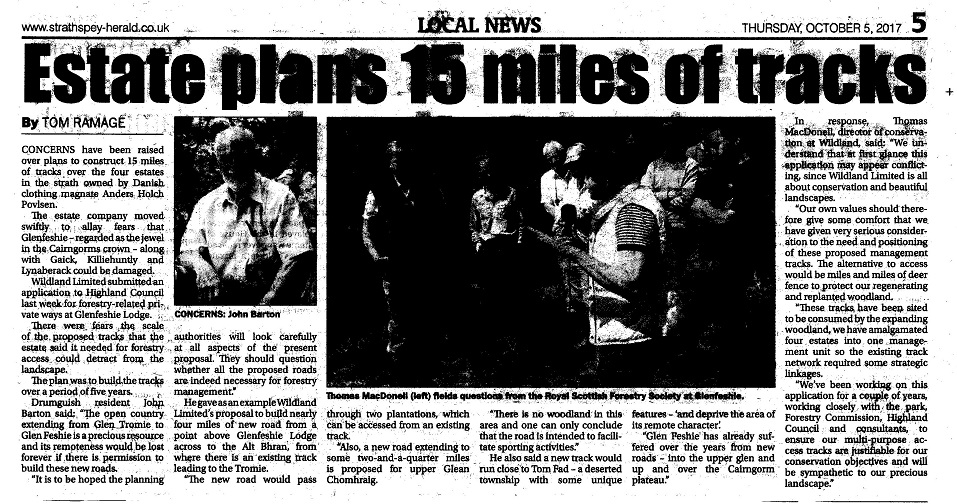 Just when it appeared that the Cairngorms National Park Authority was starting to get a grip on the proliferation of hill tracks which has blighted the Cairngorms landscape, they have blown it. Faced with a proposal by WildLand Ltd, the company controlled by Anders Povlsen, the Danish billionaire to create almost 15 miles of new hill tracks between Glens Feshie and Tromie, they have decided these can go ahead without any planning approvals. This is an astonishing decision which undermines the planning system as well and the National Park Partnership Plan approved earlier this year. (You can view all the documentation that has been made public on the Highland Council Planning portal here)
Just when it appeared that the Cairngorms National Park Authority was starting to get a grip on the proliferation of hill tracks which has blighted the Cairngorms landscape, they have blown it. Faced with a proposal by WildLand Ltd, the company controlled by Anders Povlsen, the Danish billionaire to create almost 15 miles of new hill tracks between Glens Feshie and Tromie, they have decided these can go ahead without any planning approvals. This is an astonishing decision which undermines the planning system as well and the National Park Partnership Plan approved earlier this year. (You can view all the documentation that has been made public on the Highland Council Planning portal here)
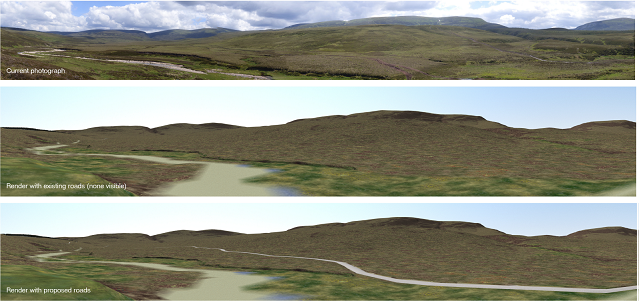
The purpose of this post is not to consider the details of the proposed tracks, which form part of a wider plan to reforest a large area between the Feshie and Tromie with native woodland and which I will consider in a further post (there are I think many positive aspects to the proposals), but to look at this decision from a policy and planning perspective. What is important here is not just the size of the proposed developments – 15 miles of track in a National Park – but that 7.3km of the track are within the Cairngorms National Scenic Area and 9 km in the Cairngorms Wild Land Area.
The policy position of the Cairngorms National Park Authority and this decision
Many conservation and recreation organisations welcomed the statement in the National Park Partnership Plan approved earlier this year that there would be a presumption against new constructed tracks in open moorland areas.
This commitment was developed further in the Main Issues Report, which set out the main areas for public consultation in the forthcoming Local Development Plan, which was considered by the CNPA Board on 6th October:
Preferred Option
The existing Local Development Plan includes a specific policy on landscape. It outlines a presumption against any development that does not conserve the landscape character and special qualities of the National Park. This has been used effectively to control and mitigate the impacts of new hill tracks in cases where they require planning permission. We think the existing policy will continue to provide an appropriate means for controlling these forms of development in the future. However, we also think that we could give more clarity on the issue of hill tracks by amending the policy to reflect the National Park Partnership Plan’s specific presumption against new tracks in areas of open moorland.
“Do you agree that the new Local Development Plan should include an amended policy to reflect the National Park Partnership Plan’s presumption against new hill tracks in open moorland areas?”
It is somewhat ironic that just the day before (see here), on 5th October, CNPA staff had emailed Highland Council that despite the potentially significant landscape impact, they were content for the proposed tracks to be dealt with by Highland Council under the Prior Notification System.
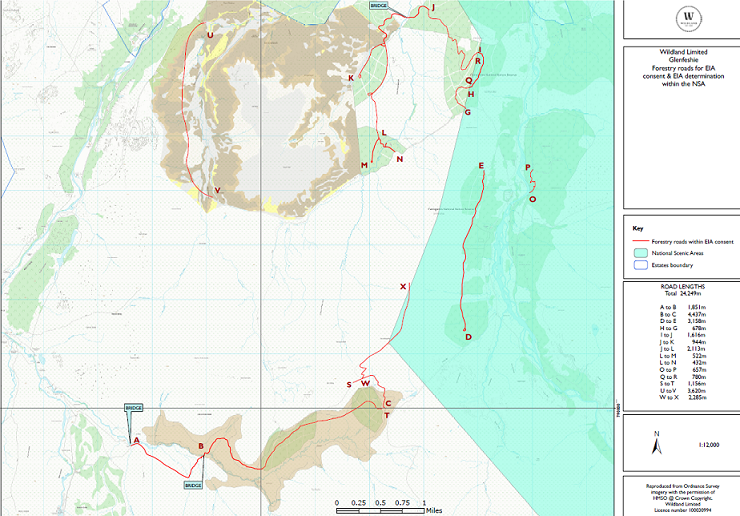
What is even more extraordinary about the CNPA decision is that back in the Spring, in their response to the Government planning consultation on People, Places and Planning they had argued (rightly in my opinion) that the whole Prior Notification system for hill tracks was flawed and that tracks should require full planning permission:
We also consider that the review should consider whether some development that can
be undertaken through prior notification or approval as agricultural and private roads
and ways should simply require planning permission. Many tracks on open moorland
and hills have some link to an agricultural purpose, even where the primary use is for
sporting activities. These tracks can be contentious, but the public may never know of
their approval nor have an opportunity to make representation on them. We suggest
that new tracks on open ground that are not in enclosed farmland should simply require
planning permission, irrespective of the purpose of the track.
The Feshie track proposal was, one might have thought, an ideal opportunity for the CNPA to consider properly the implications of a large development of hill tracks under the planning system and allow the public to comment. Instead, the CNPA have totally contravened their own policy position.
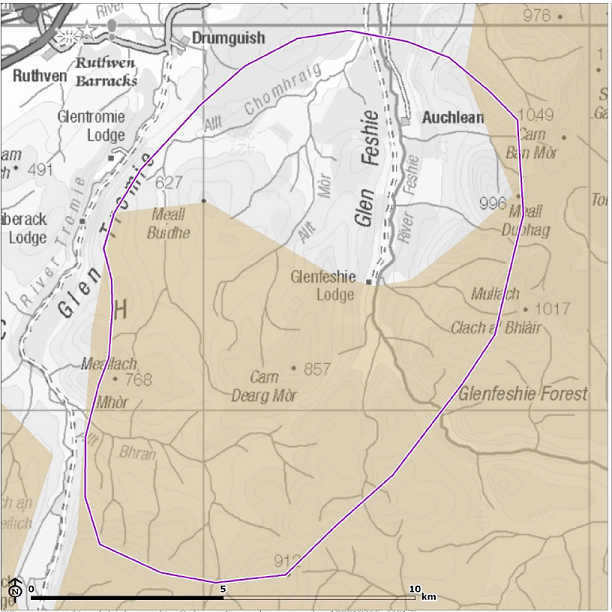
The situation is much worse than that however. By allowing the proposal to be decided under the Prior Notification system – which was introduced for agricultural and forestry tracks which are treated as permitted developments under our planning system – even if significant parts of the development were justifiable, the CNPA has lost any ability to control what happens under what the planning development and left the entire development to trust.
Where a track is agreed through the planning system, a planning authority will always attach conditions, for example about how it should be constructed. Wildland Ltd has produced far more documentation than would normally be submitted for Prior Notifications, for which it is to be commended, and many of these look good. However, not only is the public being given no chance to comment – representations from the North East Mountain Trust who were consulted privately that the visual impact of the tracks would be reduced by a vegetated central strip have been ignored – the CNPA and Highland Council now have no means of ensuring what has been proposed happens in practice. Without planning conditions, there can be no enforcement. This development is being left to trust.
What is going on?
I do not think responsibility for this mess lies with the Feshie Estate/WildLand Ltd but with our public authorities. These include Forestry Commission Scotland, SNH, Highland Council as well as the Cairngorms National Park Authority. Its clear from references in the planning documentation that Wildland Ltd consulted with our public authorities as early as last December. Its also appears that initially the CNPA did the right thing and asked for a full landscape assessment, as is evidenced by his extract from a communication quoted in the landscape assessment produced by Wildland Ltd:
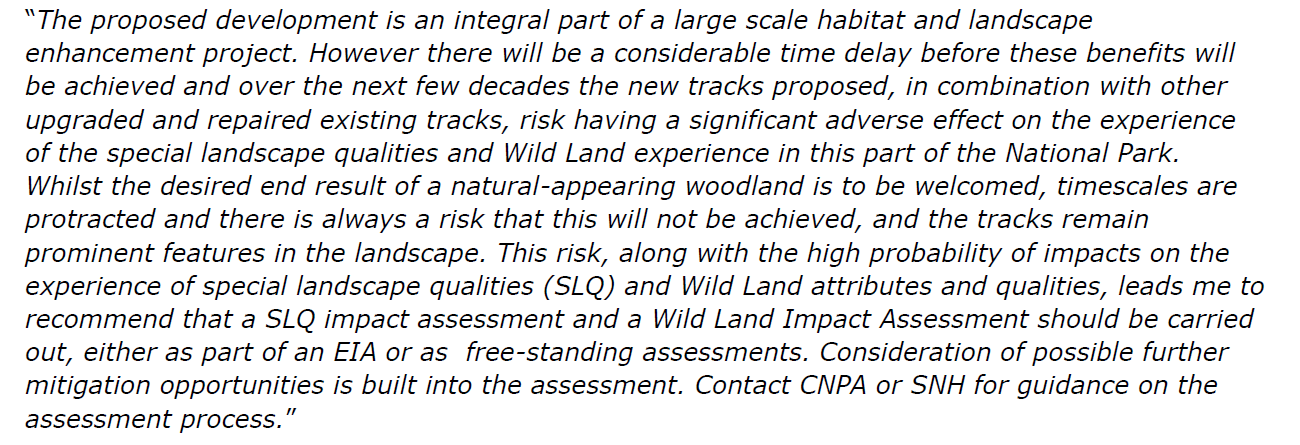
What then happened is also revealed by the WildLand Ltd documentation:
 So, just as the CNPA were telling the Scottish Government that the Prior Notification system was not fit for the purpose and before they had received any detailed information about whether the tracks could be said to be forestry or not, they had agreed that the proposals should be dealt with under the Prior Notification system. This effectively pre-judged the decision and ruled out any public engagement and consultation. I had been feeling a bit guilty that it has taken me three weeks, since I first heard about the proposals, to consider them on parkswatch but its clear the decision was effectively made well before then.
So, just as the CNPA were telling the Scottish Government that the Prior Notification system was not fit for the purpose and before they had received any detailed information about whether the tracks could be said to be forestry or not, they had agreed that the proposals should be dealt with under the Prior Notification system. This effectively pre-judged the decision and ruled out any public engagement and consultation. I had been feeling a bit guilty that it has taken me three weeks, since I first heard about the proposals, to consider them on parkswatch but its clear the decision was effectively made well before then.
There is nothing to indicate that WildLand Ltd would have objected if they had been asked to submit a full planning application which could have been considered by the public. While there are legal complexities about when a forestry track is a forestry track, the Wildland Ltd documentation makes it clear that these tracks are also to assist with deer management and have been designed to improve recreational access by walkers and cyclists. In other words they are not pretending, as many estates do, that these tracks are solely for forestry purposes and therefore don’t require planning permission. And while there might have been complexities in considering in one application tracks that did not require planning permission with those that should have required it, it is clear from the fact that WildLand Ltd submitted this as one proposal – rather than the normal track creep which is so evident in places like Drumochter – that they are trying to be open and transparent. Its our public authorities which are the issue.
I can think of several possible explanations for the CNPA’s stance, none of which in my view are appropriate for a National Park:
- A full planning application – which would have required Board visits etc – was too much work.
- The CNPA trust WildLand Ltd, in a way that they don’t trust other estates – hence they don’t see the need for planning conditions.
- That because Glen Feshie has been successfully reducing deer numbers and enabling native woodland to regenerate, its crucial to the National Park achieving its landscape scale restoration targets, and the CNPA therefore did not want to risk this being disrupted in any way through a planning application.
To me though none of these quite ring true. I had started out by thinking perhaps the CNPA was under huge pressure from Glen Feshie estate but looking at the planning I don’t think that is the case. Feshie appear to have been co-operative. I am left with the suspicion that there is some hidden factor behind this terrible decision. Perhaps the CNPA will disprove this and publicly explain their position and why they appear to have ignored their own and national policy?
Its time the CNPA started to put its money where its mouth is, trust public consultation processes and use them properly. Had they done so, I am sure the end result could have been a new track network which achieved conservation purposes but with less impact on the landscape and wild land then the current proposals. Examples of this will be considered in a future post.

Perhaps an element of Trust is required by all parties in the good intentions of Wildland Ltd. Wildland Ltd come into the category of “Good Guys” in my estimation and their approach to this matter seems to suggest that they intend to do a good job. They seem to have consulted in detail and have not just gone ahead in secret. Would it not be better to allow responsible people get on with the work – with out all the palaver and hot air that going through formal processes might generate.
It seems to me that the objection here is to the process – and not to the proposed track itself. Why not cut out the bureaucracy in this case?
Alan, I think you have identified the core of the problem, if you let the good guys as you put it not go through the planning system, how on earth can you make the bad guys go through the system? Throughout the rest of the National Park now all any landowner need do is claim they intend to plant trees on an area of open moorland and what can the National Park do without facing a legal challenge that it has behaved in a discriminatory manner?
I look forward to walking and cycling on these tracks to enjoy the views of the hills. These views will be gone in a few years with the regeneration of the forest and much of the track will disappear from view with the changing landscape. I have spent most of my life on the hills until recent years but at my age I choose to get my exercise at lower levels.